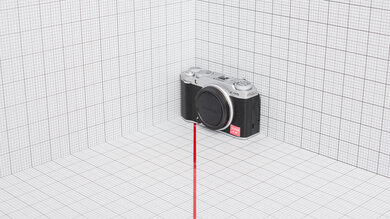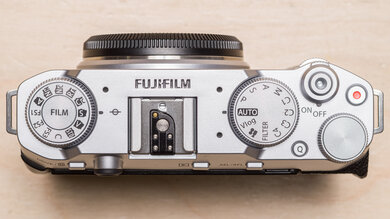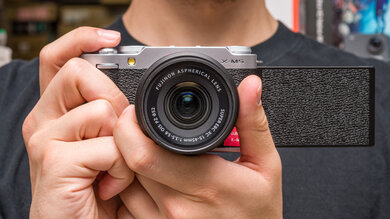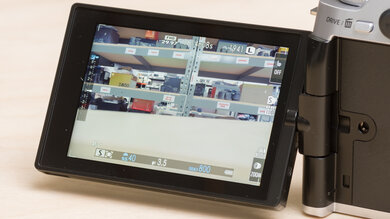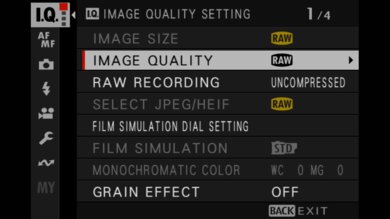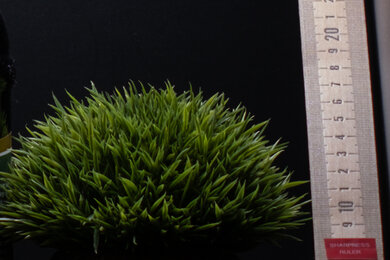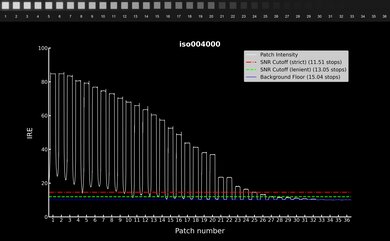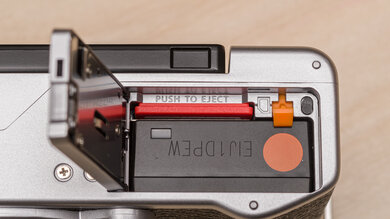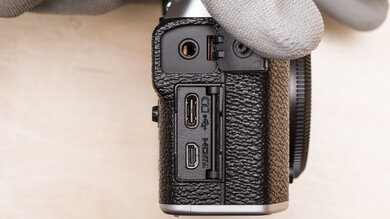The Fujifilm X-M5 is the latest entry-level option in Fujifilm's lineup and the first new X-M camera the brand has released since 2013's Fujifilm X-M1. Using the same 26 MP APS-C sensor found in previous-gen cameras like the Fujifilm X-S10 and the Fujifilm X100V, the X-M5 features a highly compact design that makes it well-suited for travel, vlogging, and everyday photography. As Fujifilm's current most affordable mirrorless option, it also fills the gap left by the entry-level Fujifilm X-T200, which was discontinued shortly after its release. Keeping costs down, however, comes with some compromises, most notably the lack of an electronic viewfinder (EVF) and in-body image stabilization (IBIS).
Our Verdict
The Fujifilm X-M5 is great for travel photography. It's remarkably compact for an interchangeable lens camera, with a large, bright screen. However, it lacks a viewfinder, which some may find limiting for photography, especially on very sunny days. While it's well-designed, with enough physical controls for a more hands-on shooting experience, its small size is a bit too cramped for those with larger hands. Thankfully, it has an excellent APS-C sensor that captures great image quality, and its autofocus system does a decent job of tracking moving subjects in busier settings. It isn't top-tier, but it's effective enough for most scenarios. Unfortunately, its battery life is just okay, so you may need a spare battery or power bank for longer days on the go.
Remarkably compact.
Great image quality.
Autofocus system tracks moving subjects well overall.
Physical controls are well thought out for the size.
No viewfinder.
Limited battery life.
Feels cramped for those with larger hands.
The Fujifilm X-M5 is great for landscape photography. It has an excellent sensor that captures great image quality, with plenty of dynamic range for high-contrast scenes. It's also remarkably compact for an interchangeable lens camera, so you can easily take it on hikes without fatigue. However, it lacks a viewfinder, and it doesn't have the best ergonomics due to its small size, though there are enough physical dials and buttons to give you some hands-on control.
Remarkably compact.
Great image quality.
Excellent dynamic range.
Physical controls are well thought out for the size.
No viewfinder.
Limited battery life.
Feels cramped for those with larger hands.
The Fujifilm X-M5 is decent for sports and wildlife photography. Its biggest limitation is a lack of a viewfinder, which makes it harder to frame and track moving subjects. On the upside, the camera's autofocus is very effective, and it supports a wide range of subject detection modes. It can also shoot at fairly quick max burst rates, particularly in its electronic shutter mode, though the e-shutter can also introduce artifacts with moving subjects. That said, if you prefer to shoot in RAW format, the camera's buffer is pretty small and takes a long time to empty once full, which can interrupt your shooting. Lastly, it doesn't have the best ergonomics for those with larger hands, but the camera's design is well thought out.
Great image quality.
Autofocus system tracks moving subjects well overall.
Physical controls are well thought out for the size.
Decently quick burst shooting.
No viewfinder.
Limited battery life.
Feels cramped for those with larger hands.
Photo buffer fills up quickly when shooting RAW files.
The Fujifilm X-M5 is excellent for vlogging. It's super portable and has a large, fully articulated screen, so it's well-suited to on-the-go vlogging. It also features a wide range of video features and punches above its class for internal recording capabilities. That includes internal 10-bit 4:2:2 recording, Log formats, 6.2k open gate capture, and 4k recording at up to 60 fps with just a slight crop. For less advanced shooters, it also offers a dedicated 'Vlog' mode, film simulation profiles to change up the look of your videos in camera, and a vertical recording mode for easy sharing to social media platforms. It also has a built-in directional mic for more precise audio recording. On the flip side, it has very noticeable rolling shutter distortion in 4k, which can be distracting in handheld videos, and it doesn't have the longest battery life for video recording, though you can always extend it with an external power source. That said, it can also overheat with longer recording sessions in more demanding recording modes.
Remarkably compact.
Fully articulated screen.
Excellent internal recording specs.
Wide range of frame rates.
Supports open gate 6.2k recording.
Limited battery life.
No IBIS.
Noticeable rolling shutter effect.
The Fujifilm X-M5 is a surprisingly powerful video camera and is very well-suited for use as a secondary camera or B-cam. It can record at up to 6.2k open gate, giving you more cropping flexibility, and it offers a range of frame rate options, as well as advanced video capabilities like 10-bit 4:2:2 internal recording and Log profiles to capture more dynamic range. Unfortunately, it doesn't have the longest internal battery life, and it can overheat with prolonged use, but you can power the camera externally if you need to extend the battery life. Despite its compact size, it includes a Micro HDMI port, headphone jack, and microphone input, and the ports are all on the opposite side of the display, ensuring cables don't get in the way of the screen. That said, the camera's lightweight design and lack of in-body image stabilization make it harder to capture smooth footage without a stabilizer or gimbal.
Excellent internal recording specs.
Wide range of frame rates.
Supports open gate 6.2k recording.
Internal 10-bit 4:2:2.
Limited battery life.
No IBIS.
Noticeable rolling shutter effect.
The Fujifilm X-M5 isn't intended for POV action video but works well for recording action. It has a fairly wide range of frame rate options, including 4k at up to 60 fps and 1080p at up to 240 fps, though the image quality degrades in its slow-motion recording mode. Rolling shutter distortion is also very noticeable with camera pans. The camera is very compact, though it lacks IBIS for more stable handheld shooting. It also doesn't have any kind of weather-sealing or water resistance.
Remarkably compact.
Wide range of frame rates.
Limited battery life.
No IBIS.
Noticeable rolling shutter effect.
The Fujifilm X-M5 captures great RAW image quality. It has excellent dynamic range to capture a wide array of highlight and shadow detail in high-contrast scenes. Images also look quite sharp thanks to its relatively high-resolution sensor, although it doesn't capture as much fine detail as models with higher-resolution sensors. Its noise handling is also only decent in low light.
Performance Usages
Changelog
- Updated Feb 12, 2025:
We wrote text for the new tests added in Test Bench 0.13.
- Updated Feb 03, 2025: We've converted this review to Test Bench 0.13. We've added new tests for Video Dynamic Range and Luminosity Patch Detection. You can learn more about these updates in the changelog.
- Updated Jan 16, 2025: Review published.
- Updated Dec 18, 2024: Early access published.
Check Price
Differences Between Sizes And Variants
The Fujifilm X-M5 comes in two colors: 'Black' and 'Silver.' We bought and tested the 'Silver' model; see its label.
You can purchase the camera body on its own or bundled with a kit lens like the FUJINON XC 15-45mm f/3.5-5.6 OIS PZ lens.
Popular Camera Comparisons
The Fujifilm X-M5 is a compact entry-level camera. While it lacks a viewfinder, it's one of the most portable APS-C options out there, with a tried and true sensor and thoughtfully designed controls, as is typical of Fujifilm. It also packs a surprisingly powerful punch under the hood, with some of the most advanced video features among entry-level cameras, as well as a highly effective autofocus system. Despite some omissions, this is one of the best-value APS-C cameras currently available on the market for beginner photographers and vloggers/video shooters.
For more options, see our recommendations for the best cameras for YouTube, the best travel cameras, and the best cameras under $1,000.
Although the Fujifilm X-M5 and the Fujifilm X100VI share some similarities, they're quite different. The X-M5 is an interchangeable lens model, while the X100VI has a fixed prime lens, making it more niche. On the surface, that makes the X-M5 more versatile, since you can pair it with a wide range of lenses. However, the X100VI has some advantages over the X-M5, including a higher-resolution sensor and a hybrid optical/electronic viewfinder. For casual photography and vlogging, the X-M5 offers better value for most people, but the X100VI is a better option for photographers who want a premium fixed-lens point-and-shoot.
The Fujifilm X-T5 is better overall than the Fujifilm X-M5. It's more robust, with better ergonomics and slightly more advanced video features. It also has a viewfinder, which makes it a better fit for photography. However, the X-M5 is significantly more compact.
The Fujifilm X100V and the Fujifilm X-M5 may share the same sensor, but they're different types of cameras in different generations in Fujifilm's lineup. The X-M5 has a newer processor, so its autofocus is more effective overall, and it has better video features. However, the X100V has an optical/electronic viewfinder and a fixed prime lens that offer a unique shooting experience and make it better for those who want a premium point-and-shoot.
The Fujifilm X-T50 is better than the Fujifilm X-M5. While they're both very portable models in Fujifilm's lineup, the X-T50 has a higher-resolution sensor as well as features like a viewfinder and in-body image stabilization that make it more well-rounded. That said, if you need a very compact interchangeable lens camera, the X-M5 is a bit smaller.
Test Results

The Fujifilm X-M5 is a very portable interchangeable lens camera. It's one of the most compact camera bodies in Fujifilm's lineup, with an even smaller and more lightweight body than cameras like the Fujifilm X-T50 or the Fujifilm X-E4.
The Fujifilm X-M5's ergonomics are passable. Its compact size makes it less comfortable for those with larger hands. Like the Fujifilm X100VI, it has a small bump on the right-hand side for grip, and the body has a textured finish, with just enough space on the back to rest your thumb. Considering its small size, the camera features quite a few physical buttons and dials, with a joystick and press functionality on the front command dial that lets you adjust up to four different settings. Like the Fujifilm X-T50, it also has a dedicated 'Film Simulation' dial to quickly adjust your picture profile.
That said, the buttons and controls are all fairly small, and the placement of certain functions, like the 'Q' button (that pulls up the quick menu) and the mic input, are a bit awkward. One nice touch, however, is that the inputs are not on the same side as the fully articulated screen, so any video peripherals won't get in the way of the screen. All in all, the controls make good use of limited real estate, but its size and certain quirks can make for a somewhat uncomfortable shooting experience.
The screen gets pretty bright and has a decently high resolution, but it's notably less sharp than pricier options like the Fujifilm X-T50. Overall, it's about on par with the screen on the Sony ZV-E10 II in terms of brightness and resolution, but for a camera that lacks an EVF, it's disappointing to not have an even brighter, higher-resolution display, especially for those who plan to shoot outdoors. Even the Canon EOS R50 has a higher-resolution screen, and that model is even cheaper and includes an EVF, so the lackluster screen is a weak point here.
Touch functionality is limited to actuating the shutter and selecting AF points and focus areas in shooting mode.
The menu system is quite good overall but isn't the most intuitive at first. Some of Fujifilm's terminology also differs from other brands, like metering settings being labeled 'Photometry.' Overall, it's easy to navigate, especially once you get used to it, but it can be a little cumbersome to get through all the sub-menus to find what you're looking for. Like the Fujifilm X-T50, there's a video-specific menu when using video mode, making it easier to access relevant video settings. Thankfully, there are also plenty of customization options, including 'My Menu' pages to access your most frequently used settings and the quick menu that you can pull up while shooting.
The Fujifilm X-M5 features a fourth-generation X-Trans sensor, which is the same one found in models like the Fujifilm X-S20, the Fujifilm X100V, and the Fujifilm X-T30 II before it. However, like the X-S20, it has the latest X-Processor 5, allowing for inclusions like AI-powered subject detection in autofocus.
The camera has an okay battery life. It's CIPA-rated for about 330 shots on a full charge, or 440 shots when in Economy Mode and about 300 in Boost Mode. These ratings are just a rule of thumb and don't necessarily reflect real-world usage, but overall, its battery life is more limited than most larger or higher-end mirrorless models, yet lasts longer than the Fujifilm X-T50, for example. If you need, you can always get a spare battery or a portable power bank to charge it on the go.
The camera's video battery life, meanwhile, is fairly limited, lasting for just under an hour of 4k video recording. It performed a bit better in our testing than the advertised battery life of approximately 50 minutes when recording in 4k at 60 fps, but overall, it's a lot shorter than many comparable cameras. That said, you can also power it externally if you need to extend its battery life.
The Fujifilm X-M5 has a decently quick 8 fps burst rate when using its mechanical shutter. When using electronic shutter mode, you can shoot at either 10 or 20 fps, or up to 30 fps with a 1.25x crop. When shooting RAW files, the buffer fills up pretty quickly, and it takes a long time for the camera to process those files and empty the buffer. However, in JPEG, you can shoot indefinitely without slowing down.
The Fujifilm X-M5 uses a similar AF system as peers like the Fujifilm X-T50. It features AI-driven subject detection algorithms with the following modes: Animal (cats and dogs), Bird (birds and insects), Automobile, Motorcycle (bikes and motorcycles), Airplane (airplanes and drones), and Train, in addition to human face/eye detection. As mentioned previously, the human detection settings are separate from the other subject detection settings, making it a bit of a hassle to switch between them.
Overall, the camera does a decent job of tracking moving human subjects. We found that while the detection feature and focus box on the display/EVF were highly accurate by staying with the subject throughout the run, the resulting photos were less consistent, with a rate of about half the frames being out of focus. Ultimately, the camera performs well in most scenarios and tracks subjects very well but can't always keep up with faster or more erratic movement.
With subject tracking disabled and using a single center focus point, the AF is a bit more inconsistent. When shooting in focus priority, the burst rate slows, and the camera doesn't always stay with the subject. Overall, though, if you can keep your subject under the focus point, and conditions are good, you can still manage a very high rate of usable or in-focus shots. We tested this camera's AF using the FUJINON XF 16-55mm f/2.8 R LM WR lens.
The Fujifilm X-M5 doesn't have in-body image stabilization, but many compatible X mount lenses have optical stabilization, including the FUJINON XC 15-45mm f/3.5-5.6 OIS PZ, with which we tested image stabilization. You can get clear handheld shots at very slow shutter speeds, though stabilization can vary depending on various factors, including but not limited to the focal length you shoot at and how steady your hands are.
The Fujifilm X-M5 has excellent dynamic range, allowing it to capture high-contrast scenes while preserving a wide range of both highlight and shadow detail. Even with shorter exposures or in dimmer lighting with more noise, details are preserved well.
While the Fujifilm X-M5's sensor doesn't have as high a resolution as the Fujifilm X-T50, for example, it still does a great job of preserving fine details, resulting in sharp-looking images, with some leeway to crop in.
The Fujifilm X-M5 has decent noise handling. Noise becomes apparent with shorter exposures or in dim lighting conditions, but it's a bit better at managing noise than entry-level competitors like the Canon EOS R10.
The Fujifilm X-M5 has surprisingly advanced video specs for its class. Like many of its higher-end stablemates, it supports 6.2k open gate recording in addition to 4k and 1080p. It also supports both F-Log and F-Log 2 to capture a wider dynamic range in video, and it can output 6.2k RAW video at up to 30 fps to an external recorder.
While there's no IBIS, the camera does have a digital stabilization feature in video mode that can smooth out some camera shake. However, enabling this feature adds a 1.32x crop to your video, as you can see in this 4k test scene extract and FHD test scene extract.
Additionally, the camera has a 'Vlog' shooting mode built into its mode dial, just like the Fujifilm X-S20. This mode has its own menu, distinct from the photo and video menus, with relevant quick settings available on the display that make it easier to adjust settings when the screen is turned around to face you. It also adds a 'Product Priority' mode that works similarly to Sony's 'Product Showcase' feature by focusing on objects held up in front of the lens, rather than prioritizing faces. 'Background Defocus' mode sets the aperture to max in order to get a shallow depth of field. There's also a 9:16 aspect ratio setting that lets you record FHD video at either 24 or 30 fps in a vertical aspect ratio without rotating the camera, making it easier to create content for social media. Finally, 'Short Movie' mode records clips of 15, 30, or 60 seconds in FHD 9:16 for easy sharing to short video platforms like TikTok or YouTube Shorts. This mode is limited to MP4 H.264, with 4:2:0 chroma sampling and small bit rates. It even includes a countdown timer on the display.
For the first time on an X series camera, the Fujifilm X-M5 features a three-way built-in directional mic. You can set it to 'Surround,' which records evenly from all directions, 'Front Priority,' which records from the front of the camera, 'Back Priority,' which records from the back, or 'Front & Back Priority,' which records from both the front and back.
There's also a 'Steady-State Noise Reduction' feature that can reduce constant background noise, like the hum of an air conditioner. Here's a demo of that feature. It takes a few seconds to identify the background noise and then cancels it out, though it can also cause some distortion and sound artifacts.
The Fujifilm X-M5 records 4k video at up to 60 fps, which is great if you want to incorporate some light slow-motion, although shooting at 60 fps incurs a 1.18x crop.
The X-M5 has remarkably good internal recording capabilities, especially considering its price point. While it can't reach the high bit rates of higher-end cameras, it supports internal 10-bit 4:2:2 recording, allowing for more flexibility in post. There are low bit rate options as well for quicker file transfers to your smartphone, for quicker uploading to social media platforms. It has no recording time limit and doesn't overheat too frequently. If overheating is becoming an issue, it's also compatible with Fujifilm's FAN-001 cooling fan, which can help prevent overheating. Additionally, the camera features 4k and FHD 'LP' (or 'Long Play') recording modes that allow you to extend the recording time by cropping in the image by about 1.18x in 4k and 1.29x in 1080p.
Overall, the camera's autofocus performs very well in video. The same subject detection modes in photo mode carry over to video, but human subject tracking can only be separately enabled from the other subject detection modes. The human subject tracking works very well. It's nearly seamless at tracking moving subjects across the frame or moving in and out. When tracking objects, the focus transitions are very quick and stay with the object well, but the camera tends to back focus a bit. With our test mug, for example, the very middle of the lettering tended to be out of focus in favor of the lettering on the sides.
In 4k LP mode, the object tracking performs well overall, as you can see in this test video.
The video quality is excellent overall. The image looks sharp and detailed, and it even performs well in low light.
To compare, here's a test scene extract from a 6.2k 30 fps recording and a 4k LP 30 fps recording.
The camera has heavy rolling shutter distortion in 4k. You'll notice skewing or wobbling with camera pans, which is especially distracting with quicker movements. In 4k LP mode, rolling shutter is the same.
The Fujifilm X-M5 can record at up to 240 fps, though shooting at 120 or 240 fps incurs a 1.29x crop. Still, the high frame rate options are great if you want to record slow-motion or high-speed action footage.
In FHD LP mode, the camera only records at 60 fps, with a 1.29x crop.
The X-M5 has remarkably good internal recording capabilities, especially considering its price point. While it can't reach the high bit rates of higher-end cameras, it supports internal 10-bit 4:2:2 recording, allowing for more flexibility in post. There are low bit rate options as well for quicker file transfers to your smartphone, for quicker uploading to social media platforms. It has no recording time limit. Additionally, the camera features 4k and FHD 'LP' (or 'Long Play') recording modes that allow you to extend the recording time by cropping in the image by about 1.18x in 4k and 1.29x in 1080p.
Overall, the camera's autofocus performs very well in video. The same subject detection modes in photo mode carry over to video, but human subject tracking can only be separately enabled from the other subject detection modes. The human subject tracking works very well. It's nearly seamless at tracking moving subjects across the frame or moving in and out.
When tracking objects, the focus transitions are very quick and stay with the object well, but the camera tends to back focus a bit. With our test mug, for example, the very middle of the lettering tended to be out of focus in favor of the lettering on the sides.
You can also see how the object tracking performs in the FHD LP mode and the FHD 9:16 vertical mode.
The camera's video quality in FHD is great. It looks sharp and detailed in more controlled lighting conditions and even in low light, there isn't an overwhelming amount of noise, with plenty of detail retention.
To compare the different modes, here's a test scene extract from the FHD LP mode and the 9:16 vertical mode. The video quality in slow-motion 240 fps is notably more degraded.
There's less rolling shutter distortion in 1080p, which is good, but you'll still notice some skewing or wobbling with quicker camera movements. In FHD LP mode, rolling shutter is the same, but it gets even worse in the vertical 9:16 mode, as you can see in this test clip, with a severe rolling shutter angle of 9.33°.
The Fujifilm X-M5 has fantastic video dynamic range. It captures a remarkably wide range above the background floor, though not all clean stops. When taking noise into account, you'll have about two to three stops fewer, which is still amazing for usable dynamic range. Overall, the camera can capture plenty of highlight and shadow detail.
When recording in 6k open gate, you'll get the following results:
- Strict SNR Max Dynamic Range: 9.33 stops
- Lenient SNR Max Dynamic Range: 11.51 stops
- Background Floor Max Dynamic Range: 15.04 stops
When recording in the '4k LP' mode, you'll get the following results:
- Strict SNR Max Dynamic Range: 9.33 stops
- Lenient SNR Max Dynamic Range: 12.02 stops
- Background Floor Max Dynamic Range: 13.92 stops
Ultimately, the oversampled 4k mode offers the cleanest results, with the widest usable dynamic range.
Tested Settings:
- Resolution: 4k
- Frame Rate: 30 fps
- Log Format: F-Log2
The camera does an especially good job of preserving shadow detail, with most of its dynamic range allocated below middle gray. Though there are fewer stops above middle gray, it still does a good job of preserving highlight detail as you raise your ISO.
Tested Settings:
- Resolution: 4k
- Frame Rate: 30 fps
- Log Format: F-Log2
The camera uses a USB-C port for charging, external power delivery, and PC connectivity for file transfers and webcam use (no additional software required). It also has a Micro HDMI port to connect an external display, as well as both a headphone jack and mic input, so you can connect any videography peripherals.

